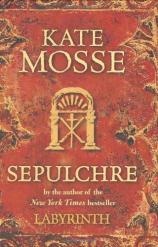Sepulchre
Review
Sepulchre
Given the rare international critical and popular acclaim that Kate Mosse’s LABYRINTH received, the only way to follow such a work would be to write a better one. With SEPULCHRE, Mosse has accomplished exactly that --- a substantial novel that reads much faster and lighter than its heft might suggest, mixing intriguing characters, dangerous situations, exotic places and fascinating times.
The general plot of SEPULCHRE is just similar enough to that of LABYRINTH to be comfortably familiar. In both books, two sets of events, people and places of the past and present slowly converge, for better and worse. SEPULCHRE, however, provides a stark contrast between its two timelines, even as both are infused with a fine and subtle hint of irony. Rennesles-Bains is the setting for events in both timelines. A picturesque town in the French mountains, it is the location of the Domaine de la Cade estate, which provides the focal point of what has happened and what will occur.
In 1891, 17-year-old Léonie Vernier, living in Paris, is invited to the Domain de la Cade by her aunt, a widow and sole occupant of the estate. Léonie is accompanied by her brother Anatole, a swell who finds it expeditious to leave the Parisian streets. Léonie, for reasons she is unable to fully articulate, is uneasy at the estate, though she is somewhat assuaged by her late uncle’s library, which, she discovers, contains a number of interesting works on the occult. She is most attracted, however, to a book dealing with the Tarot and to an account of an event taking place at a mysterious building referred to as the Sepulchre.
Even as Léonie searches for, and ultimately discovers, the enigmatic and dangerous building on the neglected grounds of the estate, danger lurks from within and without. Mysterious sounds are heard at night on the estate grounds, ones that portend a possible threat to those who live there. Meanwhile, Anatole is unaware that he is the subject of a pursuit by a maniacal enemy who seeks revenge against him as a romantic rival and who is slowly but surely ascertaining Anatole’s whereabouts.
The narrative of SEPULCHRE also reveals a parallel tale, occurring in October 2007, over a century after the events described above. Meredith Martin is an American graduate student who is in the process of writing a history of Claude-Achille Debussy, the noted French composer and, incidentally, a contemporary of Léonie and Anatole Vernier. Martin is in France for a two-fold purpose: to further research her book in Paris and trace her own uncertain lineage that centers on Rennes-les-Bains and the Domaine de la Cade, newly restored as a resort hotel. While in Paris, Martin finds herself drawn to a Tarot reader whose flier features a card whose image mirrors her own. Startled by the revelations of the Tarot --- and of Martin’s resemblance to one of the figures in the card deck --- the reader makes a gift of the deck to Martin, even as Martin flees the reading room.
But the revelations to Martin are only beginning. When she reaches Domaine de la Cade, she finds that she is haunted by the vision of a young woman whose looks are hauntingly familiar. At the same time Martin inadvertently becomes embroiled in a domestic drama involving the ownership of a hotel, a secret whose solution may well be contained on the hotel grounds, and a greed-inspired murder. As October comes to an end and November 1st --- The Feast of All Saints --- approaches, Martin slowly discovers that her fate is tied to that of Léonie Vernier and secrets of the past that have significance for the present.
SEPULCHRE succeeds on several levels. Mosse infuses its historical settings with a vividness that transports the reader across time and space. The opening pages, which describe the startling events at a musical presentation in Paris in 1891, draw one in immediately and set the pace, which continue until the story’s end. She also resists turning the book into a treatise on Tarot. A lesser writer might have used Tarotian esoteria as a filler in place of imagination; Mosse uses the topic as a vehicle, discussing it just enough to provide a general explanation of it, and nothing more. For those with little interest in the subject, this is a blessing and leaves plenty of room for what is by far the greatest strength of SEPULCHRE: the mystery. The supernatural element, nicely layered over Meredith’s and Léonie’s stories --- joining them but not overwhelming them --- complete what is in every way a superior reading experience.
If Mosse’s reputation as a master of suspense was established by LABYRINTH, then SEPULCHRE cements it.
Reviewed by Joe Hartlaub on January 23, 2011




